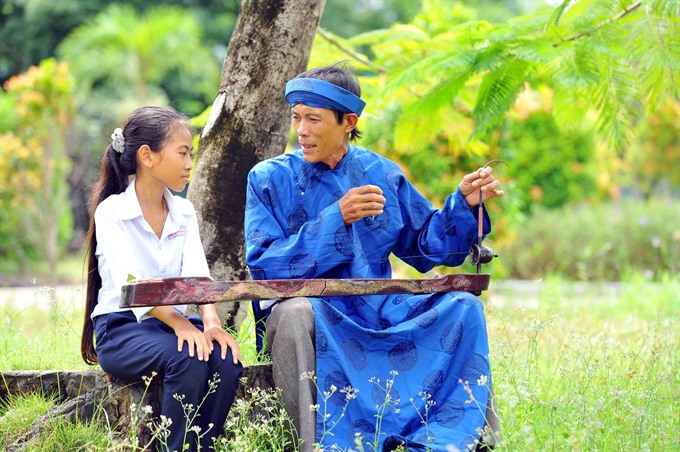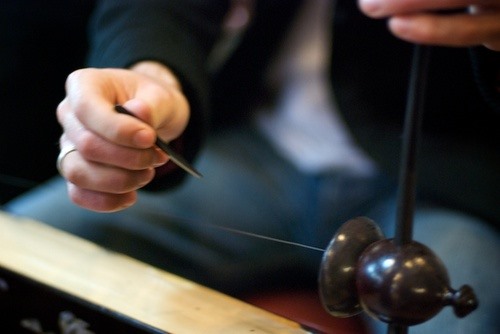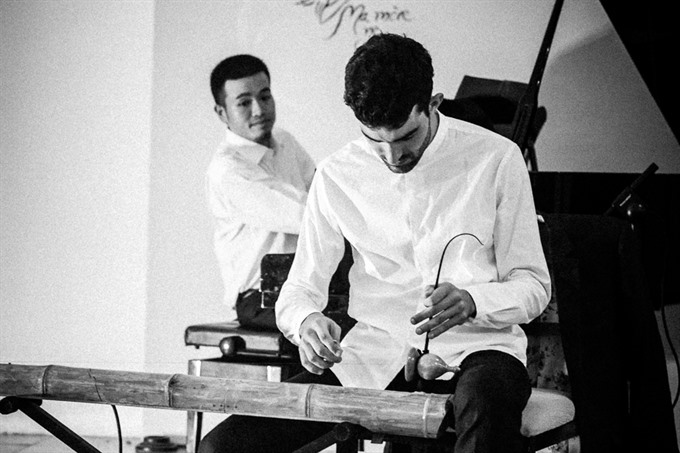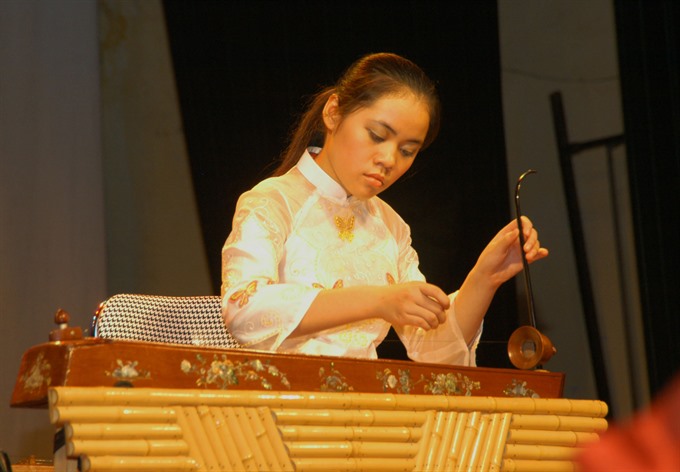 Features
Features

Đàn bầu, made from a dried gourd, a metal string, a wooden rod and a sound board, has been part of Vietnamese culture and society for hundreds of years. The soulful sounds are said to resemble the Vietnamese language, and conjure images of home for those far away, Hồng Vân reports.
 |
| Early start: To preserve đàn bầu and its music, experts recommended training talent at a very young age. –VNS Trương Vị |
Đàn bầu, made from a dried gourd, a metal string, a wooden rod and a sound board, has been part of Vietnamese culture and society for hundreds of years. The soulful sounds are said to resemble the Vietnamese language, and conjure images of home for those far away, Hồng Vân reports.
The magnificent sound of the đàn bầu, Việt Nam’s indigenous monochord zither, fascinates locals and foreigners and is an important part of the nation’s musical legacy.
The one-string zither has been long associated with Vietnamese culture and identity. The instrument once aided blind buskers to earn a living and escorted artist soldiers to war-torn battlefields. Now it accompanies artists on world stages and charms local and international audiences alike.
"Many international audiences use the phrase “đàn bầu country” or “đàn bầu’s homeland” when they talk about Việt Nam," said People’s Artist Nguyễn Tiến at a workshop about the elegant instrument in Hà Nội in October.
Monochord zithers
There are more than ten types of monochord zithers worldwide. Single-string zithers are found mostly in Asia, Africa and Southern Europe. Examples include the đàn bầu (Việt Nam), ichigenkin (Japan), ektar (India), tushuenkin (China), orutu (Kenya and Uganda) and the gusle (Serbia, Croatia and Montenegro), according to Meritorious Teacher Nguyễn Bình Định, head of the National Institute of Music.
“Compared to monochord instruments found in other countries, đàn bầu is more unique,” said Nguyễn Tiến. “Not only for its simple structure with just one string, but for the characteristic harmonics it produces and the flexible rod which is used to vary the basic tension of the string.”
 |
| Out of nowhere: Đàn bầu is unique not only for its simple structure with just one string that is invisible from a distance, but for the flexible rod that is pulled and released to vary the tension of the string. – VNS Photo Trương Vị |
The modern Vietnamese one-string zither is 1.05 metres long. It consists of a dried gourd as sound box, a string and a wooden rod. At one end of the instrument, a flexible rod passes through a bottomless dried gourd which is fixed to the sound board. At the other end, there is a peg made of buffalo horn. A metal string is attached to the rod and the peg; in the past, the string was made of fibres.
“Monochords produce a wide range of sounds. As the emitted sound is harmonics, the timbre is beautiful, deep and seductive. It is either sad or cheerful to perform human feelings,” said former head of Việt Nam National Academy of Music’s Traditional Instrument Faculty, Nguyễn Thị Thanh Tâm.
“Among Việt Nam’s musical instruments, đàn bầu sounds the most similar to the Vietnamese language,” said Tiến. “The instrument represents the Vietnamese people’s soul, characteristics and language.”
With its clear, bright, glissando effects and its sad sound, đàn bầu evokes a deep nostalgia in those living far from their homeland. Its plaintive music brings bamboo forests, paddy fields, small rivers and old temples to listeners, reminding us of a peaceful childhood in the rural countryside, said Tiến.
Legends and the past
There is no historical record of the birth of đàn bầu. But many legends and stories are still told from generation to generation about how đàn bầu came to the Vietnamese people.
It is said that in the old days, a couple lived with an elderly mother. When the son, Trương Viên, was asked to join the army, his wife, Thị Phương, took good care of her mother-in-law in their poor rural hometown. After some years, Trương Viên had not yet come back. Thị Phương and her in law wandered the region, trying to find the man. Unluckily, the two women encountered a gang of robbers during their travels. They were robbed and the young woman was blinded. The mother and daughter-in-law had to beg to live. Moved by the piety of Thị Phương, a fairy gifted her a zither and taught her how to play it. The fairy suggested Thị Phương sing and play the zither to make ends meet. After that, the two unfortunate women wandered the region and started their busking life singing traditional songs while playing the one-string zither. This is how hát xẩm (blind busker’s singing) was also created.
Đàn bầu’s existence was also recorded in ancient historic documents.
In Kiến Văn Tiểu Lục, a book on Việt Nam’s literature, geography and history, Lê Quý Đôn (1726-1784) wrote “In parties, there were often ten men and ten women sitting in two lines on the ground. Instruments including tì bà, tranh, and bầu were used to perform works with melodies which resembled ancient music.”
 |
| Avid student: Sylvain Streiff spent two years learning to play the đàn bầu in Việt Nam. –Photo Courtesy of Sylvain Streiff |
Based on Đôn’s book, many scholars feel that string instruments, like the tì bà, tranh and bầu, appeared in Việt Nam from the 13th century, said music lecturer Nguyễn Thanh Hà.
Đàn bầu’s creation remains shrouded in mystery. But scholars agree it is an indigenous instrument of Việt Nam which appeared before the 19th century, said music teacher Định.
To this day, locals still celebrate the death anniversary of the progenitor of hát xẩm with gratitude during February and August of the lunar calendar in the Hải Dương, Hải Phòng, Hưng Yên, and Vĩnh Phú areas.
Vietnamese music history
"Having been part of Vietnamese culture and society through hundreds of years of ups and downs, đàn bầu music radiates a strong vitality. The very existence of đàn bầu demonstrates the vivid expression of the cultural identity of Việt Nam," said music teacher Tâm.
According to scholar Hoàng Yến, xẩm singers in the north brought đàn bầu to Huế to accompany singing performances for the Vietnamese royal court in 1892, said Trần Quang Hải, PhD in ethnomusicology from France’s Research Centre of Ethnomusicology.
94331437PM.jpg) |
| Made in Viet Nam:The Đàn bầu, consisting of a dried gourd as sound box, a metal string and a wooden rod is an indigenous instrument of Việt Nam. –VNS Trương Vị |
At the end of the 19th century, King Thành Thái, a patriotic king during the period of French colonialism, loved đàn bầu music. Recognising the symbolism of the indigenous instrument, he decided to replace the đàn tam (36-chord zither) with đàn bầu in the royal court orchestra which included five musical instruments: tranh, tỳ, nhị, nguyệt and bầu (16-chord zither, pear-shaped 4-string guitar, two-string fiddle, moon-shaped lute, and monochord zither).
Starting in the 1950s, đàn bầu troupes were founded and many artists sought ways to develop the instrument. They began promoting the Vietnamese monochord’s role in solo, ensemble and recitation work, according to Thanh Tâm.
"1956 was a landmark year for đàn bầu: the Việt Nam National Academy of Music - the country’s first musical school - opened and đàn bầu and other traditional instruments were included in the teaching curriculum,” said Thanh Tâm.
“Whenever the country was beseiged by bombs and wars, broadcasting đàn bầu melodies on the national radio, Voice of Việt Nam was always a great encouragement for the soldiers,” said artist Kim Anh.
Famous solo đàn bầu performances - such as Vì miền Nam (For the South), Tình quê hương (Homeland Love) - were among the favourite pieces on air during 1960s and 1970s. Many such performances were chosen as theme music for radio programs, according to Kim Anh.
Đàn bầu was also so closely linked to the lives of soldiers that it was played on battlefields. This beloved music was a great comfort and encouragement to soldiers during war and a means of enriching their lives in harsh battle conditions.
Since then, the demand to learn đàn bầu has risen sharply.
"Using 5-line musical notation in studies and performance - and playing an electronic one string zither capable of a higher volume than the original instrument - helped many musicians and artists to research and apply more performance techniques," Tâm said.
Đàn bầu is an indispensable part of Việt Nam’s music scene. It holds a unique place on domestic and international music stages.
Global influence
Frenchman Sylvain Streiff first heard of the đàn bầu from his wife. He spent two years learning to play the instrument in Việt Nam in 2013-2015. Last month, he returned to the zither’s homeland to hold mini musical events featuring the instrument. "I choose đàn bầu because it is completely specific to Việt Nam," he said.
Sun Jin, a Chinese student at the Việt Nam National Academy of Music, wrote in his graduate thesis: “Đàn bầu is a unique instrument of Việt Nam which has long been played to enrich the spiritual life of Vietnamese people.”
 |
| Evoking a longing: With its clear, bright, glissando effects and its sad sound, đàn bầu evokes a deep nostalgia in those living far from their homeland. –VNS Photo Trương Vị |
"More people - including both Vietnamese and foreigners - are interested in learning about this instrument," musicianTiến said. “It is not difficult to learn to play đàn bầu. One can play this instrument beautifully, as long as they understand the soul and characteristics of Vietnamese people."
To preserve the values of this traditional instrument and to develop it further, artist Bùi Lệ Chi, a lecturer at Traditional Instrument Faculty of National Academy of Music, recommended training talent at an early age. Chi also advocated granting awards and financial support to encourage artists and teachers to compose more new works for đàn bầu.
During the workshop, researchers also urged the Việt Nam cultural authority to make a UNESCO push for đàn bầu.
"Relevant agencies need to co-ordinate and submit a proposal for UNESCO recognition of đàn bầu to assert cultural sovereignty for this instrument," Tô Ngọc Thanh, chairman of the Folk Arts Association of Việt Nam, said.--VNS




